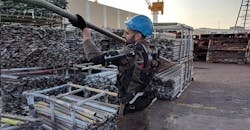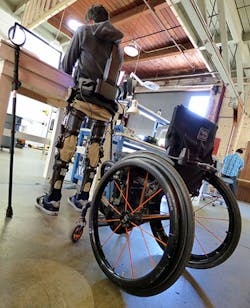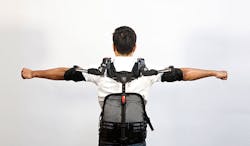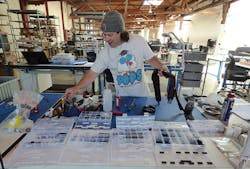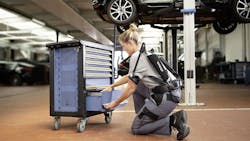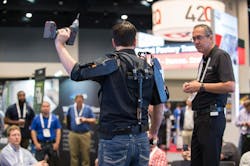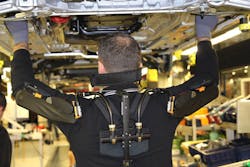It's 2019 and the workforce burdens bearing down on plant managers and supervisors are heavy enough to make Atlas break a sweat. They can't find the right people who are both willing and educated, or the best people had to go and do a stupid thing like get old. Or even worse, suffer a musculoskeletal injury on the job.
In Q1 of this year, one out of every four manufacturers turned down new business opportunities because they lacked the workers, according to the National Association of Manufacturing. Nearly every company is vulnerable, every factory susceptible, even highly automated plants run by genius billionaire philanthropists.
Last year Tesla CEO Elon Musk tweeted: "Yes, excessive automation at Tesla was a mistake. To be precise, my mistake. Humans are underrated."
Fortunately, Homayoon Kazerooni, a brilliant Iranian engineer who immigrated to the U.S. right before the Ayatollah took over, has always sought to bring out the best in humanity. He's done it through decades of research into functional exoskeletons, wearable devices that mechanically enhance human movement, from locomotion to lifting—using robots to pick up the slack for our areas of weakness.
"The writing was on the wall 20 years ago," Kazerooni laments. "Robots cannot replace people. We just cannot wait for the robots to show up. We need to come up with solutions for workers right now."
The professor at the University of California, Berkeley started by developing powered lower-body exoskeletons for soldiers hauling heavy loadouts, then transitioned to motorized leg braces that allow paraplegics to stand upright and walk.
Kaz, as he likes to be called, founded two of the leading manufacturers of these medical devices, first at Ekso Bionics and currently SuitX (where he is CEO). They are two of the four devices in the world approved by the FDA. For just this work alone, his (unofficial) title as Father of Exoskeletons would be secure, but in the last half of this decade Ekso and SuitX have developed industrial exoskeletons as the potential solution to all those workforce-related anvils resting on the chest of companies requiring manual labor.
Steven Sanchez, suitX chief pilot for its Phoenix medical exoskeleton, is also head of quality.
Ironically, as big a problem as keeping workers safe, productive and (now most importantly) willing to consider the job is, the wearable devices themselves are fairly simple. Most of the time you don’t even notice them working.
The most mature of these by a wide margin are the devices that support arms.
These passive, or unpowered, exoskeletons have one specific job: reduce the strain of lifting or holding an object, be it a box or a drill. That's it, which is enough to have every major manufacturer in automotive, aerospace, and heavy equipment finding areas to leverage this new breed of exoskeletons.
SuitX is already on its third model of its ShoulderX, which has been tailored to address user feedback surrounding comfort, weight and breathability, while still remaining at $5,000.
ShoulderX V3 weighs 7.4 lb. and has increased breathability with a mesh backing and cooling fan.
"Worker's acceptance is a huge deal. If they don’t like it, they don’t wear it," Kazerooni says.
He likens it to having an ill-fitting pair of shoes and how that could affect your ability to work. Part of that is fit, and the ShoulderX is one size fits all (except for the shorter 5% of females). For comfort, the connection to the wearer is wider and distributes the force better. Carbon fiber was added to reduce weight from 11.7 lb to just 7.4 lb.
Finally, breathability had to improve. Thomas Edison always said success was 90% perspiration, and this inventor took that to heart by personally wearing the device all day long searching for every sweat spot.
Two major improvements were made. First, the back brace was made from a nylon mesh to improve air flow. More importantly for users in high exertion or high temperature areas, a small fan was added to cool the user's back.
Other options include fire-retardant and dust-proof versions. Kazerooni says now that the ShoulderX has been improved, the LegX and BackX—which work modularly with each other and ShoulderX—will receive similar upgrades.
"We have all these options because we go everywhere and want to become universal," Kazerooni says.
They even may have a recreational unit (for hiking and other outdoor activities) by end of year.
The improvements caught the attention of Siemens Gamesa, which makes really, really huge fans (wind turbines) and has chosen SuitX as its preferred supplier to deploy at its manufacturing sites.
"Ideally, we will see a lower level of injuries and tiredness and a higher level of productivity, showing that you can do good for the company and do good for your employees at the same time," says Claus Lindberg Nielsen, head of tooling at Siemens Gamesa. "We always aim to improve our employee health and working conditions and if we can do that and at the same time save 30 seconds on a process that is repeated 1,000 times, that truly is a win for all."
Testing is ongoing and Siemens Gamesa would deploy globally if the ShoulderX's impact and adaptability can be proven.
The Rising Tide
By itself, this is an interesting development for a small company that you can’t help but love. The co-founders are former students of Kaz who use the plain office space to help patients walk for the first time with the Phoenix device and are currently scaling it down to fit children. As a testament to its dreamy ambitions, the office is next to Pixar Animation Studios. They even assemble the various exoskeletons from hand.
An assembly workstation at suitX in Emeryville, Calif.
What's most interesting, though, is how Kaz's success has led to a rush of new competitors, all out to grab a chunk of a potentially lucrative market. Global Market Insights projects the industrial exoskeletons market to rise from $27.7 million in 2018 to $459.6 million in 2026.
Aside from helping make rich investors richer, this upswing will guarantee that the choice of exoskeletons will expand while the price will drop.
"The last couple of years have been pretty transformational for the exoskeleton community," says Marty Smets, a technical expert for Human Systems and Virtual Manufacturing at Ford. "There's been a lot of onboarding in enterprise, both in aerospace and automotive and construction."
Smets' work table at Ford's Advanced Manufacturing Center near Detroit alone has three different arm-supporting exoskeletons on it: Ekso Bionics' EksoVest, SuitX's shoulderX V3, and Ottobock's Paexo.
"Many companies are going after productivity," says Smets, giving the example of a socket light assembler trying to increase installation by 10%. "We're going after injury reduction."
Each device looks a little different but are basically a series of buckles and straps sprouting off a rigid frame. The 4.5-lb. Paexo, meant for lightwork, is slender and austere, while the 9.5-lb. EksoVest is clearly more robust. Smets points out that ShoulderX's fan would come in handy in Brazil or Thailand.
He likes to keep his options open.
"I can't control how fast the technology comes out, but I can be ready to deploy the right product when the right product is ready," Smets says.
The lightweight Ottobock Paexo allows for superior flexibiltiy, but not super strength.
To that end, Ford is right in the middle of a two-year study exploring the efficacy of the $6,000 EksoVest in nine North American facilities. The surveys collect data on user discomfort, fit feel, range of motion, thermal issues, barriers keeping them from using them all the time. They are compared to a control group not wearing the devices.
Ford started with a pilot project funded by the UAW in 2017 to help the assembly workers focusing on overhead work, mostly on the vehicle undercarriage resting on a lift.
They may raise their arms 4,600 times a day, which increases the risk for those expensive shoulder injuries, like a rotator cuff tear.
EksoVest alleges to relieve strain best when lifting 5 to 15 lb. per arm, such as an impact drill or piece of paneling. So far, the evidence seems to support their usefulness.
They are looking for decreases in effective discomfort, muscle activity and an increase in endurance.
At SuitX headquarters in Emeryville, Calif., which serves as the assembly plant, office and lab, Steven Sanchez performs the dual role of chief pilot of the Phoenix medical exoskeleton and overall product quality inspector.
"We've seen significant decreases in discomfort in upper limbs and upper back," Smets says.
This is not enough to sell Smets just yet, though.
"That’s all well and good," he says, "What I don’t know, and what the world doesn’t know yet, is will it mean in two years that I will have fewer injuries on my line?"
That is the root of what Smets, and every exoskeleton user, wants to know. They won’t find out if users won’t wear them for two hours, let along two years.
"If they don’t find perceived value, they might not wear it," Smets says, "and if there is any perceived discomfort, you're going to dust it."
That's why at Michigan Assembly Plant, which underwent an overhaul for the new Ranger truck, Ford is offering their brand-new operators the chance to select their own exoskeleton that fits them best. It makes sense as they are all about the same price point ($5,000-7,000) and you wouldn’t mandate every worker wear the same size safety shoe.
"We're hoping giving them a choice like this it will increase their utilization," says Smets.
"There's a lot still to learn and the problem is every new device is different," Smets says. "What I am becoming more sure of in this wearable space is we can't count on one product to solve all problems."
Down with PPE
While Ford has methodical, err-on-the-side-of-caution approach, Toyota has already made Levitate Technologies' Airframe exoskeletons mandatory at two of their North American plants for overhead work: Woodstock, Ont., and Princeton, Ind., which assembles 400,000 SUVs and minivans a year.
The Woodstock, Ont. Plant, where the RAV4 is built, has 150 devices for use in weld shop inspections. There are more than 200 in use at the Princeton, Indiana, plant, which assembles 400,000 SUVs and minivans a year. Levitate had already earned the CE marking for PPE in Europe and has been used at BMW's Spartanburg, S.C. plant since 2016. Ford also used them at powertrain, engines and transmission plants. The device, which is in more than 100 enterprises globally, had also already demonstrated its ability to prevent fatigue, based on data collected on a Lincoln Electric VRTEX 360 welding simulator, thus keeping weld quality consistent for a longer period.
NED editor John Hitch demonstrates the Airframe as Levitate Technologies VP Joesph Zawaideh explains the lab-verified benefits at the 2018 Manufacturing & Technology Expo.
The lightweight device feels like wearing a near empty backpack. Two firm braces cup the wearers’ triceps to provide slight resistance when the arms are raised, and make the arm muscles work 80% as hard as normal.
Joseph Zawaideh, Levitate’s VP of Marketing and Business Development, explains that this is why Toyota's classified the Airframe as PPE, which was discovered through a battery of testing involving electromyography (EMG), performed by Iowa State at Toyota Canada. “They found a 20% average reduction in muscle load," Zawaideh explains.
While hooked up to wireless EMG sensors, 11 workers performed 10 various tasks at multiple repetitions. It was found to reduce muscles activity in the deltoid (shoulder muscle) in nine of 10 tasks. A study at John Deere found similar results. The upper trapezius (at back of neck), though, had slightly increased activity and the researchers suggested neck support be added.
The Airframe has several add-ons, such as a neck brace.
A lot more work need to be done in the field, and standards are still in very early stages of development, but based on purely the arm support versions, Zawaideh sees exoskeletons' near limitless potential.
"It's getting a step closer to becoming mainstream,” he says. “You're not going to say this is a great piece of innovation anymore, it going to be a be like safety glasses.”
Like Suitx, Levitate has adopted a kaizen philosophy toward product development, looking for ways to improve the user experience while keeping the price point down.
Zawaideh says they are looking at mesh straps and reducing touchpoints for better breathability, while adding high and low-reach accessories to stretch the support beyond the 30 to 140-deg. range. Anti-scratch covers for the metal components, and a head rest, are also optional.
A new FR (Flame Resistant) rated Airframe, which went into full production last month, is now used at shipyards and heavy equipment manufacturers, allows it to be used for hot work, such as welding and grinding. This version is $6,000, and required nearly all new material, from FR fabric and Velcro to an aluminum frame. The cassettes—the proprietary mechanical system of pulleys that props the arm up—could not be altered, so they are covered in FR fabric.
Levitate grew 200% from 2017 to 2018, and judging by the high level of interest Levitate's booth garnered at our sister publication IndustryWeek's Manufacturing & Technology event in April, 2019 should be another year of exponential growth.
The business side is also taking these developments seriously, indicated by a workman's compensation carrier has begun its own trials with the Airframe to see if this is a way to reduce payouts and cut customer premiums.
Exo Explosion
There's no guarantee exoskeletons are a long-term fix for any of the problems ailing the manufacturing and construction workforce, let alone all of them. Just like with robots, there will applications where they excel and others where they are more trouble than they are worth. From a storage standpoint alone, it would be hard to imagine every factory worker has their own device (it's not recommended to share due to fit and sanitary concerns).
But more than anything, what this next generation of exoskeletons prove is that there are huge opportunities for improvement and customization, and therefore, they present the very real possibility of improving more people's health and wellness.
"We're tired of people having bodies too broken to play with grandkids," says Zawaideh.
And as exoskeletons prove their worth in new jobs and with all types of workers, showing that you can perform back-breaking labor without actually breaking your back (or sustaining muscle injury), it may show younger workers that manufacturers no longer underrate their employees.
Zawaideh says early results suggest these devices will help with worker retention: "They will not resist jobs anymore because they will not have to suffer the consequences."
